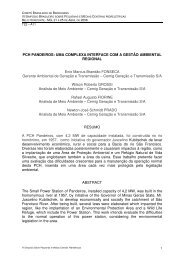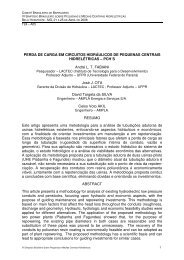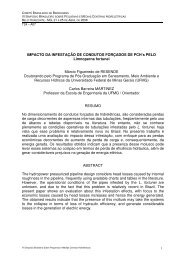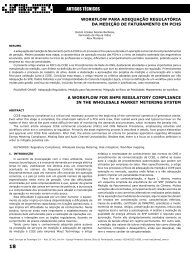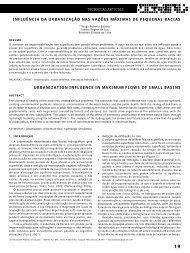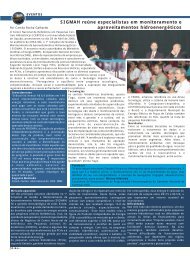Na contra mão do Mercado - CERPCH
Na contra mão do Mercado - CERPCH
Na contra mão do Mercado - CERPCH
Create successful ePaper yourself
Turn your PDF publications into a flip-book with our unique Google optimized e-Paper software.
Por Adriana barbosa<br />
o goiano Sevan <strong>Na</strong>ves é geólogo,<br />
ex-diretor <strong>do</strong> Departamento <strong>Na</strong>cional da<br />
Produção Mineiral (DNPM) e da Metais<br />
de Goías S/A (MEtAGo). Iniciou seu envolvimento<br />
com energia a partir de sua<br />
participação em projeto de geotermia,<br />
na Itália, pela oIt/oNU, em 1985. Pioneiro<br />
em seu esta<strong>do</strong> a investir em PCH,<br />
ao criar a tRItoN Energia, em 1995,<br />
quan<strong>do</strong> fez o inventário hidrelétrico <strong>do</strong><br />
rio Caiapó, no oeste de Goiás, identifican<strong>do</strong> 12 sítios promissores.<br />
Implantou e iniciou a geração da PCH Mosquitão, em 2006,<br />
sen<strong>do</strong> um <strong>do</strong>s primeiros projetos <strong>do</strong> PRoINFA. A partir daí,<br />
por conta própria, desenvolveu projetos básicos e inventários<br />
Arquivo pessoal<br />
6<br />
MERcADO<br />
“ mostra que em Goiás, apesar<br />
<strong>do</strong>s diversos aproveitamentos<br />
existentes, a expansão sofre<br />
com a falta de incentivo.<br />
”<br />
NA coNtrA <strong>mão</strong> <strong>do</strong> mErcA<strong>do</strong><br />
hidrelétricos, foca<strong>do</strong>s em PCHs. Atual-<br />
Empreende<strong>do</strong>r em PCHs mente, viabilizan<strong>do</strong> técnico/economicamente<br />
determinada PCH, faz parceria com<br />
investi<strong>do</strong>res, em sociedade de propósito<br />
específica. Neste procedimento, contabiliza<br />
nove PCHs e seis inventários hidrelétricos,<br />
só no esta<strong>do</strong> de Goiás.<br />
Ex-diretor da Associação brasileira <strong>do</strong>s<br />
Pequenos e Médios Produtores de Energia<br />
(APMPE), em 2008, fun<strong>do</strong>u e é atual<br />
presidente da Associação das Pequenas Centrais Hidrelétricas de<br />
Goiás (APCH).<br />
Nesta entrevista, Sevan <strong>Na</strong>ves, fala de seus projetos, merca<strong>do</strong><br />
e de perspectivas para o setor de pequenas centrais hidrelétricas.<br />
Entrevista com Sevan <strong>Na</strong>ves<br />
• HIDRO&HYDRO: Como o senhor avalia o merca<strong>do</strong> para as pequenas centrais<br />
hidrelétricas no Brasil?<br />
Sevan <strong>Na</strong>ves: Existe uma situação para<strong>do</strong>xal entre merca<strong>do</strong> e potencial, no<br />
brasil, vivenciada pelas PCHs.<br />
temos um potencial reconhecidamente muito alto, com incontáveis sítios<br />
interessantes ao pleno aproveitamento desta barata energia alternativa. Como o<br />
nosso modelo energético é de grande geração a longa distância <strong>do</strong> consumo, as<br />
PCHs, bem distribuídas geograficamente, tornam-se estratégicas na regularização<br />
e manutenção da oferta e suprimento energético ao sistema integra<strong>do</strong> nacional.<br />
A inobservância dessa importância e o emperramento burocrático, no entanto,<br />
dificultam a concepção e o aproveitamento correto e célere das PCHs, cujos projetos executa<strong>do</strong>s, poderiam<br />
injetar, a curto prazo, mais de 3000 MW.<br />
Agrava, quan<strong>do</strong> se nota o estrago da ausência da formatação ou continuidade de uma inteligência<br />
específica de PCH. É relevante lembrar que, no Brasil, a sua implantação foi arrefecida há mais de 70<br />
anos. Por isso, sentem-se a falta de informações básicas. Inclusive, não se tem registros oficiais, pois os<br />
levantamentos hidrelétricos <strong>do</strong> Governo contemplaram - até então - apenas os sítios acima de 50 MW.<br />
Com os esforços da iniciativa privada, a partir <strong>do</strong> simples aceno governamental, em 2001, com os<br />
incentivos <strong>do</strong> PRoINFA, este potencial teve uma instantânea e forte revelação positiva.<br />
PCH Rênic<br />
Isso, no entanto, foi apenas um lampejo, vez que não se tinha uma efetiva e consistente política de rênic SHP<br />
fomento a essa fonte energética abundante no País.<br />
Daí, fatores negativos devi<strong>do</strong> à descontinuidade <strong>do</strong> PRoINFA, crise internacional de 2008, e com a queda<br />
nas tarifas decorrente da episódica entrada mergulhante das eólicas nos leilões, erroneamente concorren<strong>do</strong> com as PCHs, o cenário<br />
conturbou-se lamentavelmente.<br />
Para piorar, as bruscas oscilações <strong>do</strong>s valores <strong>do</strong>s PPAs (<strong>contra</strong>tos de venda de energia, que servem de garantia bancária)<br />
dificultaram os financiamentos a longo prazo, assustan<strong>do</strong> os investi<strong>do</strong>res.<br />
tornou-se, pois, difícil à viabilização das PCHs nos moldes concebi<strong>do</strong>s na fase pré-PRoINFA.<br />
Isto obrigou os parcos empreende<strong>do</strong>res mais obstina<strong>do</strong>s a se adequarem à nova realidade. Consciente <strong>do</strong> fato de se tratar de<br />
obra simples, rústica e rápida, tornou-se necessário o desenvolvimento de uma tecnologia própria. Daí, somente tiveram sucesso<br />
aqueles empreende<strong>do</strong>res que obtiveram tal tecnologia, que resultasse em redução drástica de custos e simplificasse os procedimentos<br />
construtivos. Desta forma, teve-se que fugir <strong>do</strong>s modelos turn key, no project finance. A assunção da administração direta na obra<br />
está sen<strong>do</strong> peça fundamental para obter a viabilidade almejada. Em paralelo, foi aguçada a sensibilidade <strong>do</strong>s fabricantes, a reduzirem<br />
ao máximo os custos <strong>do</strong>s equipamentos eletromecânicos reforçada pela momentânea crise industrial.<br />
Por fim, é inacreditável constatar que, ten<strong>do</strong> extraordinário potencial e um merca<strong>do</strong> consumi<strong>do</strong>r demandante, além da importância<br />
estratégica, as PCHs estão sem condições básicas de se alavancar normalmente. o que falta é uma política compromissada de governo,<br />
regulan<strong>do</strong> melhores preços das tarifas, <strong>do</strong> financiamento, reduções de encargos e incentivos à indústria.<br />
ou seja, um novo PRoINFA, com adequações à nova realidade, notadamente na questão <strong>do</strong> PPA, capacitação das linhas de transmissão<br />
e redução <strong>do</strong>s encargos financeiros, seria alvissareiro ao setor da energia alternativa, em PCH, que novamente daria um salto positivo.<br />
Arquivo pessoal
Mr. Sevan <strong>Na</strong>ves is a geologist from<br />
the state of Goiás, former director of<br />
the <strong>Na</strong>tional Department of Mineral<br />
Productions (DNPM) and of MEtAGo –<br />
Metais de Goiás S/A. His involvement with<br />
energy started after he participated in a<br />
geothermal project carried out in Italy<br />
by the IlA/UNo in 1985. He became a<br />
pioneer in his state when he invested in<br />
SHP by creating tRItoN Energia in 1995,<br />
when he carried out the hydropower study of the River Caiapó<br />
in the west on the state, identifying 12 promising potentials. He<br />
implemented Mosquitão SHP in 2006, which was one of the first<br />
PRoINFA’s projects. After that, on his own, he developed Proposals<br />
MARkET<br />
“ in spite of the several existing<br />
SHP potential in the state of<br />
Goiás, the expansion suffers<br />
from the lack of incentives.<br />
”<br />
oPPoSitE tHE mArkEt<br />
Translation: Adriana Candal<br />
and hydropower inventories focused on<br />
Entrepreneur shows that SHPs. today, by making certain SHPs<br />
technically and economically feasible, he<br />
establishes partnerships with investors<br />
in a partnership of specific purpose. By<br />
<strong>do</strong>ing so, he is already responsible for<br />
9 SHP and 6 hydropower inventories in<br />
the state of Goiás alone. Former director<br />
of the brazilian Association of Small<br />
and Medium Power Producers (APMPE),<br />
2008, he founded and is the president of the Association of Small<br />
Hydropower Plants of the state of Goiás (APCH).<br />
In this interview Mr. Sevan <strong>Na</strong>ves talks about his projects,<br />
the market and his perspectives for the SHP sector.<br />
Interview with Mr. <strong>Na</strong>ves<br />
• HIDRO&HYDRO: How <strong>do</strong> you assess the market for mall hydropower plants in Brazil?<br />
mr. <strong>Na</strong>ves: the SHP experiment a para<strong>do</strong>xical situation between the market and the<br />
potential in brazil.<br />
the country has a recognized high potential with numerous sites that can be fully<br />
used to generate this alternative and cheap energy. As our energy model is characterized<br />
by a generation far from the final-consumer, should the SHPs be well-distributed,<br />
geographically speaking, they might become a reasonable strategy aiming at the<br />
regulation and maintenance of the energy offer and supply to the national integrated<br />
system.<br />
However, the lack of importance given to this fact and the bureaucratic slowness<br />
make the conception, the correct and agile use of SHPs difficult. Today, SHPs projects<br />
that could have been carried out would be able to inject over 3000 MW in the short run.<br />
this whole situation gets worse when it is possible to notice the damage that the<br />
absence of a format or continuity of a specific SHP intelligence. It is important to<br />
highlight that here in brazil their implementation was set aside for over 70 years. this is<br />
the reason why there is a lack of basic information. There are no official records, for the<br />
government hydropower reports comprised only sites over 50 MW.<br />
With the efforts of the private sector and after a simple signal from the government<br />
in 2001 with the incentives from PRoINFA, this potential became instantaneously strong<br />
and positive.<br />
However, this was only a glimpse, given that there was not an effective and consistent<br />
foment policy to this abundant energy source of the country.<br />
then, negative factors caused by the interruption of PRoINFA, the 2008 international crises, and the sharp drop in the tariffs due<br />
to the entrance of the wind energy in the auctions at full throttle, mistakenly competing with SHP, made the scenario even gloomier.<br />
Things got worse when the sharp oscillations of the PPA values made long tern funding difficult, scaring the investor away.<br />
The feasibility of SHP following the models conceived within the phase pre-PROINFA became difficult.<br />
this forced the fewer, but more obstinate, entrepreneurs to adjust themselves to this new reality. Aware of the fact that it<br />
represented simple, rustic and fast work, it was necessary the development of its own technology. this way, only those entrepreneurs<br />
that had access to such technology, resulting in a sharp reduction in costs and simplifying the construction procedures, succeeded.<br />
Then, it was necessary to run away from turnkey models in the project finance. A greater participation of the direct management in<br />
the work has become a key element to attain the desired feasibility. At the same time, the manufacturers were challenged to reduce<br />
the cost of their electro-mechanical equipment, reinforced by the passing industrial crisis.<br />
At last, it is unbelievable to notice that having an extraordinary potential and a highly demanding consumer market, as well as their<br />
strategic importance, the SHPs <strong>do</strong> not have the basic conditions to achieve great results on their own. the government must come up<br />
with an engaged policy, regulating the prices of the tariffs, the funding, tax reductions and industry incentives, i.e., a new PRoINFA<br />
adjusted to the new reality, for example, the PPAs, power lines and the reduction of financial taxes, would be favorable to the SHP<br />
alternative energy sector which would surely give a positive response.<br />
7
Arquivo pessoal<br />
• HIDRO&HYDRO: Em sua área de atuação como estão os<br />
investimentos na geração de energia por meio das PCHs?<br />
Sevan <strong>Na</strong>ves: Diante desta crise fabricada pela inércia governamental<br />
e o merca<strong>do</strong> instável, os investimentos em PCHs foram<br />
drasticamente reduzi<strong>do</strong>s. Restam apenas os obstina<strong>do</strong>s ou abnega<strong>do</strong>s<br />
envolvi<strong>do</strong>s diretamente, no intuito de fazer a coisa acontecer.<br />
• HIDRO&HYDRO: Quais são as dificuldades que o setor<br />
vem enfrentan<strong>do</strong>, atualmente, no que se refere a Regulação,<br />
Licenciamento Ambiental e Merca<strong>do</strong>?<br />
Sevan <strong>Na</strong>ves: A morosidade na liberação das outorgas pela<br />
ANEEl, os equívocos e excessiva burocracia <strong>do</strong> licenciamento<br />
ambiental, alia<strong>do</strong> aos baixos PPAs, que impedem o acesso aos financiamentos,<br />
são as dificuldades que obstaculizam a viabilidade<br />
da implantação das PCHs.<br />
Esta inexplicável sequência de entraves leva o empreende<strong>do</strong>r<br />
a opções, no mínimo, hetero<strong>do</strong>xas. Por isso, tem empreende<strong>do</strong>r<br />
que optou por fazer 40 CGHs <strong>do</strong> que uma PCH, justifica<strong>do</strong> apenas<br />
pela simplicidade burocrática e o ganho <strong>do</strong> tempo de implantação,<br />
para fazer caixa.<br />
Além da busca tecnológica para reduzir custos, outra opção<br />
que se tem a<strong>do</strong>ta<strong>do</strong>, para conseguir melhores preços nas tarifas,<br />
é a busca de PPA diretamente junto ao médio consumi<strong>do</strong>r livre,<br />
aceitável pelos agentes financeiros.<br />
• HIDRO&HYDRO: Em relação a fornecimento de equipamentos,<br />
o senhor acredita que as indústrias nacionais estão aptas a<br />
atender o merca<strong>do</strong>?<br />
Sevan <strong>Na</strong>ves: os fabricantes, entenden<strong>do</strong> o momento, quan<strong>do</strong><br />
diretamente também foram atingi<strong>do</strong>s, reagiram bem, a ponto<br />
de, inclusive, competir com os importa<strong>do</strong>s da China, ofertan<strong>do</strong><br />
preços e condições mais compatíveis.<br />
Agora, haven<strong>do</strong> incentivos fiscais e creditícios, os custos <strong>do</strong>s<br />
equipamentos podem reduzir mais ainda e viabilizar melhor as PCHs.<br />
8<br />
MERcADO<br />
• HIDRO&HYDRO: Quais seriam os desafios a serem transpostos<br />
pelas PCHs frente às eólicas?<br />
Sevan <strong>Na</strong>ves: Há um entendimento incorreto quan<strong>do</strong> se faz<br />
comparação das eólicas com as PCHs.<br />
O Brasil precisa ter uma matriz energética diversificada,<br />
abarcan<strong>do</strong> todas as alternativas. Porém, isto deve estar embuti<strong>do</strong><br />
num programa de governo abrangente, que contemple todas as<br />
fontes e seu peso na oferta energética nacional. No bojo, tem-se<br />
que reconhecer que a vocação histórica brasileira é pela energia<br />
hidráulica, que temos abundante. Então, deve-se esgotar este<br />
potencial, independente <strong>do</strong> surgimento e aproveitamento correto<br />
de outras fontes.<br />
outro erro que grassa é confundir função complementar com<br />
concorrência. É importante ressaltar que o momento de melhor<br />
aproveitamento <strong>do</strong>s ventos é justamente no perío<strong>do</strong> de baixas<br />
vazões hídricas e vice-versa. Então, num programa de governo<br />
isto deveria ser considera<strong>do</strong> como complementação e não<br />
concorrência de uma e outra fonte, atentan<strong>do</strong> aos seus diversos<br />
melhores momentos. Deve-se levar em conta a rigidez locacional<br />
de cada fonte de eletricidade.<br />
De qualquer forma, mesmo diante das razões de as eólicas derrubarem<br />
os preços das tarifas nos leilões, com baratos equipamentos<br />
importa<strong>do</strong>s e poder ter rápida implantação (significa retorno<br />
financeiro rápi<strong>do</strong>) sem a necessidade de passar pela via-crucis ambiental,<br />
é necessário rever os méto<strong>do</strong>s conceptivos das PCHs, completa<strong>do</strong><br />
com o devi<strong>do</strong> desenvolvimento de tecnologia específica.<br />
Isto no senti<strong>do</strong> de baratear os custos e poder fazer uma<br />
comparação razoável, entre as PCHs e eólicas.<br />
É valioso esclarecer que um fator determinante, na economicidade<br />
e praticidade da implantação de uma PCH, depois de<br />
identificar um sítio hidrelétrico, é aplicar a melhor investigação<br />
geológica. Ao utilizar as ferramentas apropriadas da pesquisa,<br />
definem-se bem os possíveis riscos, a segurança e as opções<br />
de locais de implantação. Este fator, com a prévia identificação<br />
correta <strong>do</strong> ambiente geológico, pode simplificar o arranjo geral<br />
e, daí, a meto<strong>do</strong>logia construtiva pode ser concebida excelentemente.<br />
• HIDRO&HYDRO: Como estão os investimentos <strong>do</strong>s gera<strong>do</strong>res<br />
de energia associa<strong>do</strong>s no esta<strong>do</strong> de Goiás?<br />
Sevan <strong>Na</strong>ves: o território goiano é privilegia<strong>do</strong>. Por ser cabeceira<br />
das grandes bacias hidrográficas, ter boas vazões e <strong>do</strong>ta<strong>do</strong> de<br />
uma geologia básica de suporte, detém um potencial peculiar e<br />
interessante para PCHs.<br />
Com o <strong>do</strong>mínio <strong>do</strong> conhecimento dessas características, temnos<br />
permiti<strong>do</strong> a projeção segura em possíveis custos bem mais<br />
baixos <strong>do</strong>s, até então, pratica<strong>do</strong>s.<br />
Assim, temos a PCH Mosquitão (30 MW), já geran<strong>do</strong>, e a<br />
construção, neste momento, da PCH tamboril (29,3 MW) e da<br />
PCH Rênic (16 MW) e da PCH Santo Antônio (30 MW), ora tocada<br />
pelo eng. Emival Caia<strong>do</strong> (Grupo Rialma).<br />
Para o próximo ano, programamos o início da PCH Jacaré (26<br />
MW) e da PCH Cocal (10 MW).<br />
Hoje, basicamente somente os goianos da tRItoN e RIAlMA,<br />
com estas PCHs, estão se aventuran<strong>do</strong>, na implantação de PCHs<br />
em Goiás.<br />
Isto é muito pouco, diante <strong>do</strong> alto potencial de Goiás,<br />
expressa<strong>do</strong>, em parte, pelos 90 projetos de PCH tramitan<strong>do</strong> na<br />
ANEEl e em órgãos ambientais, além da grande quantidade de<br />
Inventários Hidrelétricos e das 19 PCHs em geração, desde 2006.<br />
Com um simples estímulo, só as PCHs de to<strong>do</strong> o país, em<br />
tramitação na ANEEl, poden<strong>do</strong> ser viabilizadas e implantadas,<br />
suplantaria a projeção de várias grandes hidrelétricas, que ora<br />
tem a oposição acirrada de ambientalistas.
• HIDRO&HYDRO: In your area, what are the investments in<br />
SHP energy generation like?<br />
mr. <strong>Na</strong>ves: Facing this crisis created by the inertia of the<br />
government and by the instable market, the SHP investors have<br />
been drastically reduced. there are only those who are obstinate,<br />
those who are directly involved in making things happens.<br />
• HIDRO&HYDRO: Today, what are the difficulties the sector<br />
has been facing in relation to Regulation, Environmental License<br />
and Market?<br />
mr. <strong>Na</strong>ves: the slowness of Aneel to release the grants, the<br />
mistakes and the excessive bureaucracy of the environmental<br />
licensing, together with the low PPAs that forbid the access to<br />
funding, are the obstacles to the implementation of SHPs.<br />
this inexplicable sequence of obstacles forces the entrepreneurs<br />
to find options that are, at least, hetero<strong>do</strong>x. There is an<br />
entrepreneur that decided to build 40 Hydropower Generating<br />
Units instead of one SHP - an act that was justified by the bureaucratic<br />
simplicity and by the gain in the implementation time<br />
to re-establish the cash-flow.<br />
besides the technologic search to reduce costs, another<br />
option that has been a<strong>do</strong>pted to get better tariff prices is the<br />
search of PPAs directly from the medium free consumer, which is<br />
accepted by the financial agents.<br />
• HIDRO&HYDRO: In relation to equipment supply, <strong>do</strong> you<br />
believe that the national industry is prepared to meet the market<br />
demand?<br />
mr. <strong>Na</strong>ves: the manufacturers, understanding the moment when<br />
they were also directly hit, reacted well to the situation. they<br />
could compete with equipment imported from China, offering<br />
prices and more compatible conditions.<br />
Now, when there are fiscal and financial incentives, the cost<br />
of equipment can go <strong>do</strong>wn ever more, which will be much better<br />
for the SHPs.<br />
• HIDRO&HYDRO: What are the challenges that SHPs must<br />
overcome against wind energy?<br />
mr. <strong>Na</strong>ves: there is an incorrect understanding when wind<br />
energy is compared to SHPs.<br />
Brazil must have a diversified energy matrix, embracing all the<br />
alternatives. However, this must be embodied in a governmental<br />
program that comprehends all the sources and their weight<br />
in the national energy offer. It is important to recognize that,<br />
historically, brazil has always has a vocation for water energy,<br />
which is abundant here. this way, this potential must be used,<br />
regardless of the appearance and the correct use of other sources.<br />
Another mistake is to confuse complementary function with<br />
competition. It is important to highlight that the best use of the<br />
wind takes place during the low flows of the rivers and viceversa.<br />
then, this should be considered as a complement in a<br />
governmental program, not as a competition to another source,<br />
and their best moments must also be taken into account.<br />
Also, the place strictness of each electricity source must be<br />
considered.<br />
Anyhow, even due to the reasons why wind energy made<br />
the tariff prices drop in the auctions with inexpensive imported<br />
equipment and a fast implementation (meaning a fast investment<br />
return) without the need to undergo the environmental via<br />
crucis, it is necessary to review the conceiving methods of the<br />
SHPs, complemented by the appropriate development of specific<br />
technology - this only in the sense of reducing prices and having<br />
a reasonable comparison between wind energy and SHPs.<br />
It is also important to mention that a determining factor<br />
regarding the economic and practical aspects of the implementation<br />
MARkET<br />
of SHPs, after identifying a hydropower potential, is to apply the<br />
best geological investigation. When the appropriate tools of the<br />
research are used, the possible risks, the safety and the best<br />
implementation areas can be well-defined. This factor, with the<br />
previous correct identification of the geological environment, may<br />
simplify the general arrangement, therefore, the constructive<br />
metho<strong>do</strong>logy may be conceived with excellence.<br />
• HIDRO&HYDRO: What can you tell us about the investments<br />
of the energy generators in the state of Goiás?<br />
mr. <strong>Na</strong>ves: the territory of Goiás is privileged. because it<br />
has the springs of large hydrological basins, it has good flows<br />
and a basic geology of support, the state holds a peculiar and<br />
interesting potential for SHPs.<br />
the understanding of these characteristics has allowed us to<br />
have an accurate projection of costs that are considerable lower<br />
than the ones that have been practiced so far.<br />
this way, there is Mosquitão SHP that is already generating<br />
energy (30 MW) and the construction of tamboril SHP (29.3 MW)<br />
and Rênic SHP (16 MW) and Santo Antônio SHP (30 MW), which<br />
is now in charge of engineer Emival Caia<strong>do</strong> (Grupo Rialma).<br />
Jacaré SHP (26 MW) and Cocal SHP (10 MW) are forecast to<br />
start.<br />
today, only tRItoN and RIAlMA (companies from Goiás),<br />
with these SHPs, are venturing the implementation of SHPs in<br />
the state.<br />
this is too little, facing the potential of the state, which can be<br />
shown by the 90 SHP projects that are being analyzed by ANEEl<br />
(<strong>Na</strong>tional Agency for Electric Power) and other environmental<br />
organs, by the large number of Hydropower inventories and the<br />
19 SHPs that have being operating in the state since 2006.<br />
With just a small push, if only the SPHs from all over the<br />
country that are being analyzed by ANEEl could be implemented,<br />
their power would surpass the projection of several large<br />
hydropower plants, which now are facing great opposition from<br />
environmentalists.<br />
Arquivo pessoal<br />
Casa de Força PCH Mosquitão<br />
Power house: Mosquitão SHP<br />
9



